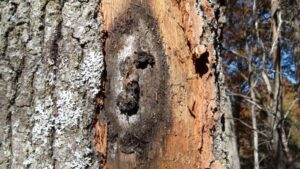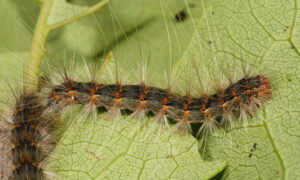Learn to recognize these common symptoms that may save your tree:
We think of trees at as stalwart sentries, watching over our yards and weathering any storm with us. Though they seem impervious to the changing world around them, like us, trees can become stressed.
Stress in a tree can lead to disease, die-back, decay, and even death if not addressed quickly. There are many factors in a tree’s life that can stress it out, but they can typically be categorized into one of two kinds of stresses: biotic or abiotic.
In this post, we will take a brief look at common biotic stress and its typical symptoms to help you better recognize possible problems with your tree:
What is Biotic Stress?
A biotic stress is caused by a living organism, such insects, fungi, bacteria, etc., predating or parasitizing on part or all the tree. Most biotic pests have coevolved in conjunction with a species of tree and have become specific to those trees.
If you notice symptoms of a biotic stress in an oak tree, there is little risk of it spreading to non-oak trees in your yard. The list of biotic stressors is too large to cover comprehensively but keep reading for some of the most common biotic stresses trees see in North Texas.
Trees that Commonly Experience Biotic Stress
Oak Wilt
 Oak wilt occurs when the vessels that move water throughout the tree become clogged by a fungal colony, disrupting the normal flow of water from the roots to the branches and leaves. Because of this, it appears as if the tree is wilting from drought even when plenty of water is available.
Oak wilt occurs when the vessels that move water throughout the tree become clogged by a fungal colony, disrupting the normal flow of water from the roots to the branches and leaves. Because of this, it appears as if the tree is wilting from drought even when plenty of water is available.
As the name implies, this affects oak trees, but some more than others. Red oaks and Live oaks are most susceptible to oak wilt, while other species are more resistant. Symptoms of oak wilt include browning, prematurely falling leaves, and eventually death.
Emerald Ash Borer
Emerald Ash Borer is a small, green insect that infests ash trees. They have already caused widespread devastation in areas of the U.S. more heavily planted with ash trees with only a handful of sightings around the Dallas-Fort Worth metroplex.
If you have an ash tree in your yard, keep an eye out for abnormally thick sucker growth at the base of the tree and branch die-back starting at the highest branches. If you suspect your ash tree has been infested, please contact the Texas A&M Forestry Service immediately.
Annual Insect Pests


The other common insect activity is fall webworm and tent caterpillars. They make large silk nest in the branches of trees, defoliating small sections of the tree’s canopy. Usually, the damage stops at minor defoliation (trees drop their leaves in the fall anyways, a few leaves early wont hurt) but they can occasionally infest a tree so thick that they cause serious damage. If web nests start popping up on more than one or two branches, it may be time to do something about them.
When considering the state of a tree, it is important to recognize whether the symptom you are looking is the primary stress or a secondary problem taking advantage of the trees weakened state. This can be difficult to distinguish but is imperative to properly diagnose the needs of your tree.
If you suspect your tree is unhealthy, call your local, friendly, certified arborist to consult on the best course of action to save or mitigate damage to your tree.
